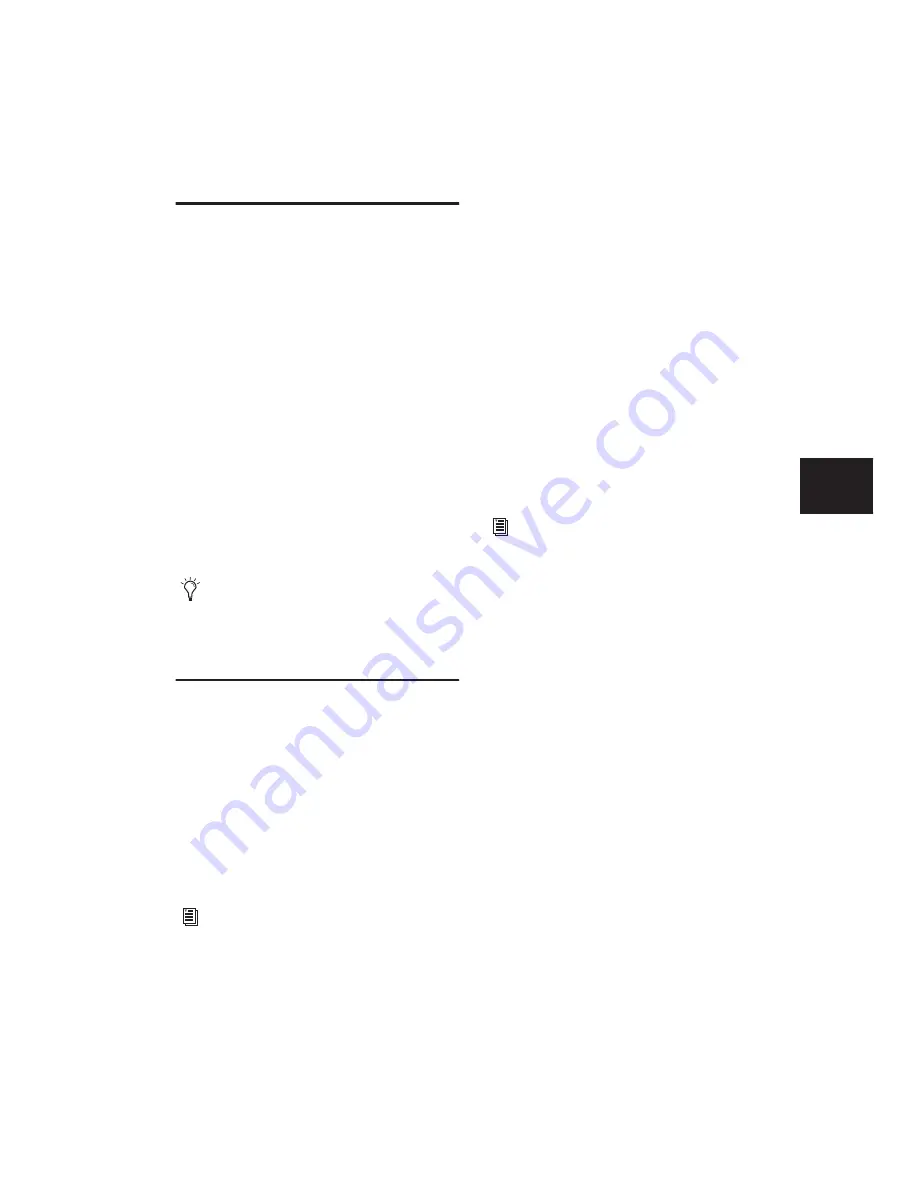
Chapter 15: Audio Recording
281
Record Pause Mode
When recording a large number of tracks or
channels, or playing back a large number of
tracks while recording, Pro Tools may take a lit-
tle longer to begin recording. To avoid this de-
lay, put Pro Tools in Record Pause mode before
beginning to record.
To record from Record Pause mode:
1
Click Record in the Transport. The Record but-
ton flashes.
2
Alt-click (Windows) or Option-click (Mac)
Play in the Transport to put Pro Tools in Record
Pause mode. The Play and Record buttons both
flash.
3
To begin recording instantaneously, click Play.
4
Click Stop to stop recording.
Recording Additional Takes
After recording to an audio track, you can record
additional takes to the same track. However, if
you record these additional takes in Destructive
Record mode, the audio residing on your hard
drive from the previous takes is permanently
lost.
To keep the audio from previous takes, record
the new takes in Normal (Nondestructive)
Record mode.
To nondestructively record a new take on the
same track:
1
In the Options menu, ensure that the follow-
ing options are deselected: Destructive Record,
Loop Record, QuickPunch, TrackPunch, and De-
structivePunch.
2
Record enable the track.
3
Do one of the following:
• To record from the beginning of the ses-
sion, click Return to Zero in the Transport.
– or –
• If Options > Link Timeline and Edit Selec-
tion is enabled, click anywhere in the
track’s playlist to begin recording from that
point.
4
Click Record in the Transport to arm Pro Tools
for recording.
5
Click Play to start recording.
6
Click Stop to stop recording.
An audio file for the new take is written to disk
and appears as an audio region both in the
track’s playlist and in the Region List.
The audio from the original take remains on
your hard drive, and is still available as a region
in the Region List.
When synchronizing to time code, use
Record Pause mode to record or play back
large numbers of tracks. This decreases the
time it takes to lock to time code.
For information on audio file and region
names for new takes, see “Default Track
Names” on page 264.
To record a specific track range, with precise
start and end points, see “Punch Recording
Audio” on page 283.
Summary of Contents for Pro Tools
Page 1: ...Pro Tools Reference Guide Version 7 3 ...
Page 15: ...1 Part I Introduction ...
Page 16: ...2 ...
Page 33: ...19 Part II System Configuration ...
Page 34: ...20 ...
Page 44: ...Pro Tools Reference Guide 30 ...
Page 94: ...Pro Tools Reference Guide 80 ...
Page 95: ...81 Part III Sessions Tracks ...
Page 96: ...82 ...
Page 108: ...Pro Tools Reference Guide 94 ...
Page 130: ...Pro Tools Reference Guide 116 ...
Page 269: ...255 Part IV Recording ...
Page 270: ...256 ...
Page 310: ...Pro Tools Reference Guide 296 ...
Page 345: ...331 Part V Editing ...
Page 346: ...332 ...
Page 402: ...Pro Tools Reference Guide 388 ...
Page 496: ...Pro Tools Reference Guide 482 ...
Page 548: ...Pro Tools Reference Guide 534 ...
Page 571: ...557 Part VI MIDI Editing ...
Page 572: ...558 ...
Page 596: ...Pro Tools Reference Guide 582 ...
Page 637: ...623 Part VII Mixing ...
Page 638: ...624 ...
Page 702: ...Pro Tools Reference Guide 688 ...
Page 771: ...757 Part VIII Video Sync Surround ...
Page 772: ...758 ...
Page 792: ...Pro Tools Reference Guide 778 ...
Page 806: ...Pro Tools Reference Guide 792 ...
Page 856: ...Pro Tools Reference Guide 842 ...






























